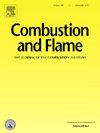Mach reflection of detonation waves with velocity deficits
IF 5.8
2区 工程技术
Q2 ENERGY & FUELS
引用次数: 0
Abstract
Velocity deficits, which exist universally in the process of detonation propagation, were not considered in the problem of detonation Mach reflection in previous studies. Thus, an experimental study of the Mach reflections of gaseous detonations with velocity deficits is reported in this paper. Remarkable velocity deficits were achieved by a porous wall channel. The soot foil technique was utilized to monitor the cellular pattern variation and the evolution of triple-point trajectory. Two detonable mixtures, i.e., 2H2+O2+3Ar and 2H2+O2, were used to obtain stable detonation and unstable detonation. The results show that along with velocity deficits, the detonation tends to be unstable and the cell size increases. The induction length must be taken into consideration since the specific heat ratio could be different from that of a Chapman-Jouguet (CJ) detonation. Therefore, three modes of self-similarity were determined, i.e., non-self-similarity with significant velocity deficits (mode 1), global self-similarity with moderate velocity deficits (mode 2) and localized self-similarity with slight velocity deficits (mode 3). The Mach stem height of mode 1 is higher than the non-reactive three-shock theory. The triple-point trajectory of mode 2 corresponds to that of an inert shock. In the case of mode 3, the well-known frozen and equilibrium limits in detonation Mach reflections can be found. Considering the measured cell size () as the length scale, the required transition distance for the occurrence of the equilibrium limit was found to be approximately (8–10). A threshold value =0.95 was found above which the Mach reflection characteristics of a detonation agree well with those of a CJ detonation ( is the overdrive degree of the incident wave). Below the threshold value, the triple-point trajectory angle decreases linearly with the increase of , and the Mach stem overdrive degree is a constant.
有速度缺陷的爆轰波的马赫反射
速度缺陷在爆轰传播过程中普遍存在,但在以往的研究中并未考虑爆轰马赫反射问题。因此,本文报告了对具有速度缺陷的气体爆轰马赫反射的实验研究。多孔壁通道实现了显著的速度缺陷。利用烟尘箔技术监测了蜂窝模式的变化和三点轨迹的演变。利用两种可爆混合物,即 2H2+O2+3Ar 和 2H2+O2,获得了稳定起爆和不稳定起爆。结果表明,随着速度的减弱,起爆趋于不稳定,细胞尺寸增大。由于比热比可能不同于查普曼-朱盖特(CJ)起爆,因此必须考虑诱导长度。因此,确定了三种自相似模式,即速度严重不足的非自相似模式(模式 1)、速度适度不足的全局自相似模式(模式 2)和速度轻微不足的局部自相似模式(模式 3)。模式 1 的马赫干高度高于非反应式三次冲击理论。模式 2 的三点轨迹与惰性冲击的轨迹一致。在模式 3 的情况下,可以找到众所周知的爆炸马赫反射的冻结和平衡极限。将测量到的电池尺寸(λ)作为长度尺度,发现出现平衡极限所需的过渡距离约为 (8-10)λ。发现了一个阈值 αi=0.95 ,在此阈值之上,起爆的马赫反射特性与 CJ 起爆的马赫反射特性非常一致(αi 为入射波的超速度)。在临界值以下,三点轨迹角随αi的增大而线性减小,马赫茎超速度是一个常数。
本文章由计算机程序翻译,如有差异,请以英文原文为准。
求助全文
约1分钟内获得全文
求助全文
来源期刊

Combustion and Flame
工程技术-工程:化工
CiteScore
9.50
自引率
20.50%
发文量
631
审稿时长
3.8 months
期刊介绍:
The mission of the journal is to publish high quality work from experimental, theoretical, and computational investigations on the fundamentals of combustion phenomena and closely allied matters. While submissions in all pertinent areas are welcomed, past and recent focus of the journal has been on:
Development and validation of reaction kinetics, reduction of reaction mechanisms and modeling of combustion systems, including:
Conventional, alternative and surrogate fuels;
Pollutants;
Particulate and aerosol formation and abatement;
Heterogeneous processes.
Experimental, theoretical, and computational studies of laminar and turbulent combustion phenomena, including:
Premixed and non-premixed flames;
Ignition and extinction phenomena;
Flame propagation;
Flame structure;
Instabilities and swirl;
Flame spread;
Multi-phase reactants.
Advances in diagnostic and computational methods in combustion, including:
Measurement and simulation of scalar and vector properties;
Novel techniques;
State-of-the art applications.
Fundamental investigations of combustion technologies and systems, including:
Internal combustion engines;
Gas turbines;
Small- and large-scale stationary combustion and power generation;
Catalytic combustion;
Combustion synthesis;
Combustion under extreme conditions;
New concepts.
 求助内容:
求助内容: 应助结果提醒方式:
应助结果提醒方式:


